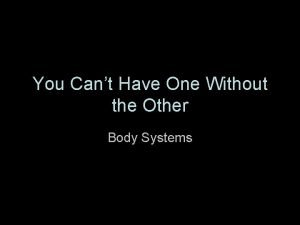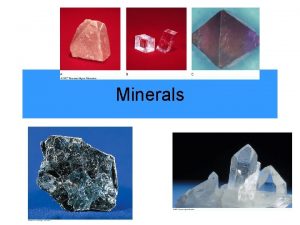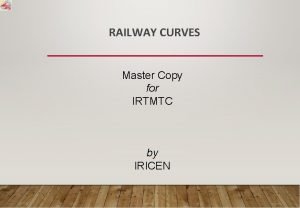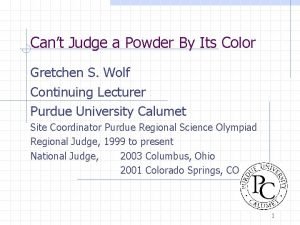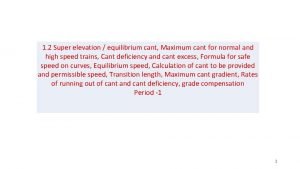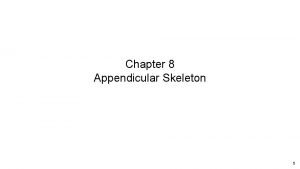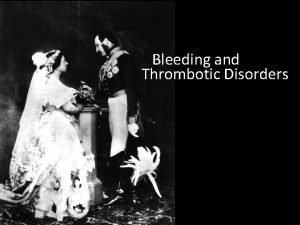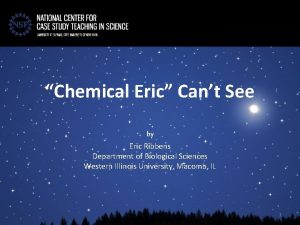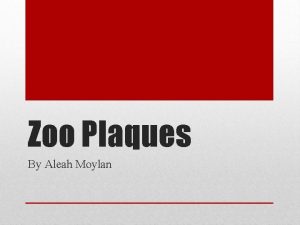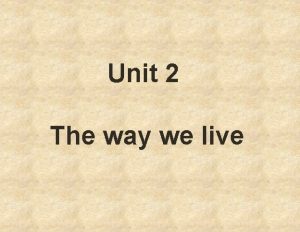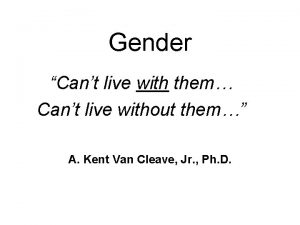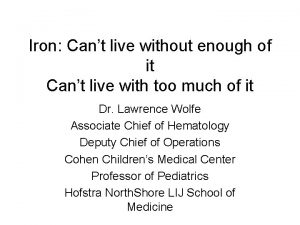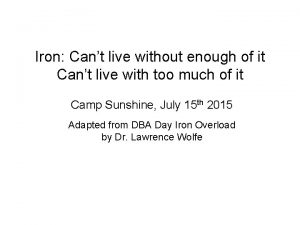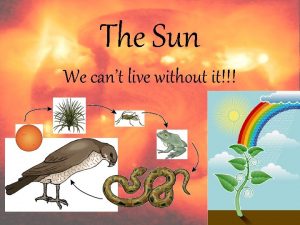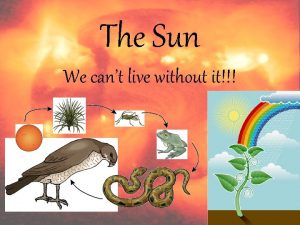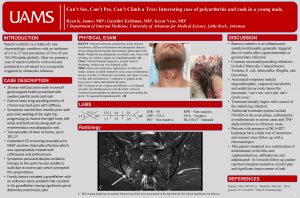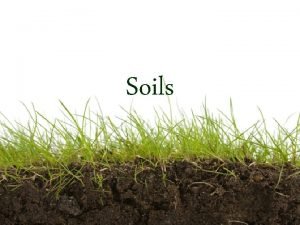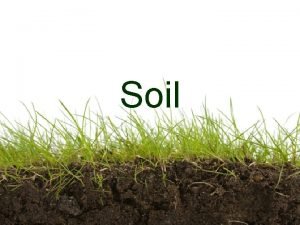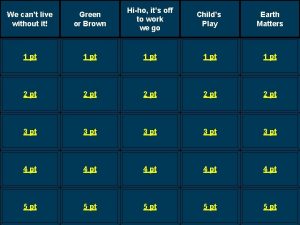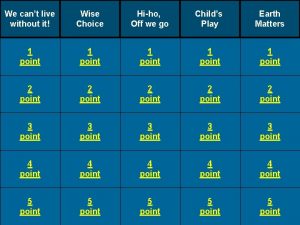Water We Cant Live Without It Water Water


























































- Slides: 58

Water We Can’t Live Without It

Water, Water Everywhere • Makes up 50 -70% of total body weight • Can survive for only a few days without water • It is found in: – Intracellular fluid – Extracellular fluid • Moves across cell membranes by osmosis


Functions of Water • Solvent for virtually all biochemical reactions • Helps maintain body temperature • Helps maintain proper osmotic pressure • Helps remove waste products • Serves as shock absorber surrounding joint and in production of amniotic fluid • Need roughly 8 cups of water a day



Water is lost from body through • • • Sweating Breathing Urine Feces Loose to much water body responds by producing thirst response • If thirst is ignored produce Antidiuretic hormone stimulates kidneys to retain water • Triggers set of reactions leading to increased blood pressure



Water Regulation • Pituitary gland releases antidiuretic hormone (ADH) • ADH causes kidneys to reduce urine flow and increase water reuptake • Fall in BP causes kidney to release renin • Renin activates angiotensin II in the heart & lungs • Angio II causes adrenal glands to release aldosterone • Aldosterone causes kidney to retain salt, and therefore water as well




Water Toxicity • Drinking too much water can cause water intoxication – Concentration of electrolytes in blood falls (esp Na) causing hyponatremia – Affects osmotic pressure, action potential generation – Symptoms: headache, blurred vision, muscle cramps, convulsions, and death (brain swells from too much water)

Minerals What good are they?

Minerals • Major minerals are required in relatively large quantities • Trace minerals are also required but in much smaller amounts • One factor in the absorption of minerals is their Bioavailability • All of the divalent cations are absorbed by the same mechanisms • If too many are present at the same time they can interfere with each others absorption • Some types of fiber may also tie up minerals so they are not available for absorption



Sodium (Na) • • 95% of ingested salt is absorbed Easily absorbed from stomach, Sm. Int, Lg. Int Na is excreted via urine, sweat and GI tract Only 10% of Na consumed is actually needed - rest is excreted Na+ is major positive ion in ECF and for maintaining electrical gradients across membrane Na+ also used for glucose and AA transporters in intestine As Na+ and K+ move across membranes, they create an electrical potential charge Na+ also high in blood, used to maintain osmolarity


Sodium in Foods • About half the Na we eat is added at the time of eating • Other portion of Na is added to food during production • Major Na foods are: white breads, hot dogs, lunch meats, cheese, soups, tomato sauce, most sauces, and fried foods


Sodium Needs • Only about 200 mg of Na is needed per day for normal physiological functions • AI is 51 -1500 mg/day • UL is around 2400 mg/day • Under FDA labeling rules, 2400 mg per day is assumed in the diet • Most people’s Na intake is around 4700 mg per day • Very high levels of Na cause water retention, and thus high BP • When going to low Na diet you can substitute oregano, lemon juice, garlic, and other herbs and spices

Sodium Deficiency • Low Na in diet, along with dehydration, sweating, vomiting, depletes Na • Causes muscle cramps, nausea, vomiting, dizziness, shock, and coma • Very unlikely due to kidney regulation of Na and aldosterone

Sodium Deficiency • When water loss is 2 or 3% (5 or 6 lbs) Na loss becomes noticable • Further loss causes fatigue, muscle cramps, dizziness, and confusion Sodium Toxicity • Only toxic when high Na is taken in without much water- overloads the kidney and causes thick urine • No UL for Na yet

Potassium (K) • We absorb about 90% of K consumed • K balance achieved primarily through kidneys, aldosterone is regulatory hormone • K highest inside cells • K is also involved in maintaining osmolarity, much like Na • K also involved in creating an electrical potential across membrane

Potassium in Foods • Not generally added to foods • Fresh fruits and vegetables are highest in K, as well as milk, whole grains, potatos, and meats Potassium Needs • AI is 4700 mg/day • DV is 3500 mg/day • Average intake for most Americans is 2100 -3300 mg/day


Potassium Deficiency • Hypokalemia • People in most danger are one who take diuretics, as well as alcoholics due to inhibition of ADH • Anorexia nervosa or bulemia can cause K drop due to vomiting • Symptoms are loss of apetite, weakness, fatigue, cramps, confusion, constipation, irregular heartbeat, increased BP, stroke Potassium Toxicity • Excess K is harmless with good kidneys • Hyperkalemia- excess K in blood causes slowed heartbeat and/or cardiac arrest

Chloride (Cl) • Absorbed in Sm. Int and colon • Excreted through kidneys, skin, and GI tract • Cl- is important negative ion in ECF • Key in maintaining electrolyte balance • Used to make HCl, and in white blood cell antigen recognition • Helps in acid-base balance and disposes of CO 2 via exhaled air

Chloride in Foods • Most Cl consumed as salt added to foods (Na. Cl) • Seaweed, olives, rye, lettuce, some fruite and vegetables also have Cl Chloride Needs • AI for Cl is 2300 mg/day • DV is 3400 mg/day • Since most adults consume about 7. 5 g of Na. Cl per day, we get around 4. 5 g of Cl

Chloride Deficiency • Very unlikely due to high Na. Cl intake • Only seen with frequent vomiting in addition to nutrient poor diet Chloride Toxicity • UL set at 3. 6 g/day • Cl implicated along with Na in HBP • Cl intake over 15 g per day cause fluid retention

Calcium (Ca) • Ca absorbed mostly in duodenum, since it needs slightly acidic (p. H 6) to be absorbed by 1, 25(OH)2 D 3. • We absorb about 25% of Ca ingested, but during infancy and pregnancy, can be as high as 60% • Young people absorb Ca much better than older people, due to decreasing Vit D levels with age • Every cell in our bodies has vital need for Ca • Normal blood Ca can be maintained for quite a while despite inadequate Ca intake

Calcium (Ca) Regulation • When Ca falls, the parathyroid gland releases parathyroid hormone (PTH) • PTH and 1, 25(OH)2 D 3 increase the kidneys reabsorption of Ca from urine • PTH also increased Ca absorption indirectly by increasing 1, 25(OH)2 D 3 • PTH and 1, 25(OH)2 D 3 also increase osteoclast activity, removing Ca from bone • Some Ca is also lost through the intestine as part of digestive process



Calcium Functions • Bone development and maintainence – Osteoblasts lay down new bone matrix – Osteoclasts break down bone matrix – Bone matrix composed of hydroxyapatite (Ca 10(PO 4)6 OH 2) – Bone is constantly made and broken down, according to Ca needs of body – During growth and through adulthood, osteoblast activity exceeds osteoclast activity • Only past age 35 -40 does osteoclast activity exceed osteoclast

Calcium Functions – Bone mass and Ca deposition also increased by exercise and weightresistance activities – Risks for lowered bone mass include: genetics, slim build, irregular menstruation, use or corticosteroids, caffiene, alcohol, and prolonged bed rest



Calcium Functions • Blood Clotting- Ca participates in the formation of fibrin, as well as conversion of prothrombin to thrombin • Transmission of APs at axon terminal – Arrival of AP at axon terminal causes voltage-gated Ca channels to open – Ca needed for docking of vesicles of NT to axon membrane, and release into synaptic cleft – With low Ca, APs sometimes generate spontaneously, causing hypocalcemic tetany- muscle spasms



Calcium Functions • Muscle Contraction – When a muscle is stimulated, Ca is released from the SR – Ca allows for movement of tropomyosin from actin, allowing myosin to bind to it – Ca is then returned to SR by Ca pumps • Cell Metabolism – Part of Calmodulin system- Ca binds to calmodulin inside a cell and the complex can regulate activity of many enzymes • Ca may also reduce risk of colon cancer by binding bile and free FAs • Ca might also reduce symptoms of PMS


Calcium in Foods • Dairy products most abundant in Ca (except for cottage cheese) • White bread, crackers and other foods made with milk products are also high • Highest nutrient density Ca foods are broccoli, leafy greens, nonfat milk, salmon, romano cheese, swiss cheese, sardines • Calcium supplements can also be used, but must be monitored carefully or Ca toxicity can result – No more than 1000 mg/day of Ca in supplement for in divided doses of 500 mg each


Calcium Needs • AI for Ca is 1000 -1200 mg per day • For people 9 -18, it is 1300 mg/day • In the US, avg Ca intake is – 600 -800 mg/day for women – 800 -1000 mg/day for men Calcium Toxicity • Normally Sm. Int prevents excess Ca from being taken in • Ca supplements can cause calcification of body tissues, kidney stones, kidney failure, headaches, prostate cancer, and decreased absorption of other minerals • UL for Ca is 2500 mg/day

Calcium Deficiency • Osteoperosis is greatest risk • Women especially at risk due to lower production of estrogen, and hence vitamin D after menopause • Physical activity and weight resistance help to reduce rate of bone loss • Estrogen Replacement is another option – Estrogen- bind to receptors on bone and reduce bone loss – Bisphonates- stop bone resorption by binding to hydroxyapatite – Selective estrogen receptor modulators- same as estrogen – Calcitonin- inhibits osteoclast activity

Phosphorus (P) • About 70% absorbed in adults, 90% in children • 1, 25(OH)2 D 3 plays major role in P absorption • P is excreted by the kidneys • P found in all body tissues and is vital for survival – 80% of P is in bones and teeth – Is also a component of many enzyme systems, ATP, DNA, RNA, and phospholipids in cell membranes

Phosphorus in Foods • Milk, cheese, yogurt, and meat are high in P • Cereals, eggs, bran, nuts and fish are good secondary sources • Around 30% of P comes from food additives, either as preservatives or phosphoric acid Phosphorus Needs • RDA is 700 mg/day for adults • Most adults in US consume 1000 to 1600 mg per day


Phosphorus Deficiency • Usually found in preterm infants, vegans, alcoholics, elderly with poor diets, and people using Al containing antacids daily • Usually show bone loss, decreased growth, anorexia, weight loss, weakness, irritability, stiff joints and bone pain Phosphorus Toxicity • Not harmful unless already renal stress • Reduced kidney excretion leads to high blood P and Ca causes P/Ca precipitates to form in body tissues, and contributes to bone loss by increasing PTH levels

Magnesium (Mg) • Usually absorb 40 to 60% of Mg ingested • 1, 25(OH)2 D 3 somewhat enhances Mg absorption • More than 300 enzyme catalyzed reactions in the body need Mg to function properly – Mg binds to ATP to form active ATP – Mg contributes to DNA and RNA during cell proliferation – Also involved in Ca and P metabolism, and therefore bone production – Important in nerve and heart function – Used in release of insulin from pancreas

Magnesium in Foods • Plant products high in Mg such as whole grains, broccoli, squash, green leafy vegetables, beans, nuts, seeds, and chocolate • Most tap water is fortified with Mg too (as well as Ca and fluoride) Magnesium Needs • RDA is 400 mg/day for men and 310 mg/day for women • In the US, men consume 325 mg/day and women 225 mg/day


Magnesium Deficiency • Usually only seen in users of some diuretics which causes excess Mg excretion in urine • Heavy perspiration for weeks or vomiting and diarrhea can cause Mg loss too • Alcoholics often low in Mg • Symptoms are irritibility, rapid heartbeat, weakness, muscle spasms, disorientation, nausea, vomiting, seizures, and eventually death Magnesium Toxicity • UL is 350 mg/day, but only dangerous with certain laxatives and antacids • Symptoms are diarrhea, renal failure, malaise, nausea, slowed breathing, and death

Sulfur (S) • S usually found in nonionic form as part of organic compounds – Found in biotin and thiamin – AAs methionine and cysteine contain S too, and present in proteins – Found in collagen as disulfide bonds, and in keratin – Also found as sulfate (SO 42 -) which is used in maintaining acid-base balance of the body
 If you can’t measure it, you can’t manage it
If you can’t measure it, you can’t manage it If you cant measure it you can't manage it
If you cant measure it you can't manage it Cant have one without the other
Cant have one without the other Https //quizlet.com live
Https //quizlet.com live Live happy live healthy
Live happy live healthy Can we live without minerals
Can we live without minerals Water and water and water water
Water and water and water water Who’s the author of “without title”?
Who’s the author of “without title”? Without a title poem
Without a title poem Alliteration in keeping quiet
Alliteration in keeping quiet Railway curves iricen
Railway curves iricen O doamne mare cand privesc eu lumea
O doamne mare cand privesc eu lumea Shawn der kinderen
Shawn der kinderen If you cant beat them join them
If you cant beat them join them Jeb likes cars but he cant drive yet
Jeb likes cars but he cant drive yet Can't judge a powder
Can't judge a powder Equilibrium cant formula
Equilibrium cant formula Shy lovers try positions that they can't handle
Shy lovers try positions that they can't handle Bleeding
Bleeding Rail cant
Rail cant Cant stop the feeling trolls go noodle
Cant stop the feeling trolls go noodle Cant cove base
Cant cove base Metal roof parapet details
Metal roof parapet details From can to cant
From can to cant I bet you cant
I bet you cant If you can't measure it, you can't manage it
If you can't measure it, you can't manage it I cant count
I cant count Modal auxiliary verb
Modal auxiliary verb Why cant we see atoms
Why cant we see atoms Close your eyes to what you cant imagine
Close your eyes to what you cant imagine Why we cant see air
Why we cant see air You cant manage what you dont measure
You cant manage what you dont measure Eric ribbens
Eric ribbens I cant but he can
I cant but he can Base anhydrides are “base without water”.
Base anhydrides are “base without water”. Agriculture without water
Agriculture without water Zoo plaques
Zoo plaques Live sccoe
Live sccoe Video movie
Video movie Which biome do we live in
Which biome do we live in [email protected]
[email protected] We live in a broken world
We live in a broken world Present tense of live
Present tense of live Two nations live on the edge answers
Two nations live on the edge answers Twinspace etwinning login
Twinspace etwinning login Monkeys live in trees
Monkeys live in trees Office live word
Office live word Mi'kmaq haudenosaunee and anishinabe similarities
Mi'kmaq haudenosaunee and anishinabe similarities Dead front vs live front transformer
Dead front vs live front transformer Singular and plural
Singular and plural Vikings and africa
Vikings and africa Population of south yorkshire
Population of south yorkshire The passionate shepherd to his love figurative language
The passionate shepherd to his love figurative language Twitch the original markz
Twitch the original markz King is dead long live the king
King is dead long live the king The just shall live by his faith
The just shall live by his faith What mountain range did the incas live in
What mountain range did the incas live in The book is dead long live the book
The book is dead long live the book Blue dragon life cycle
Blue dragon life cycle


